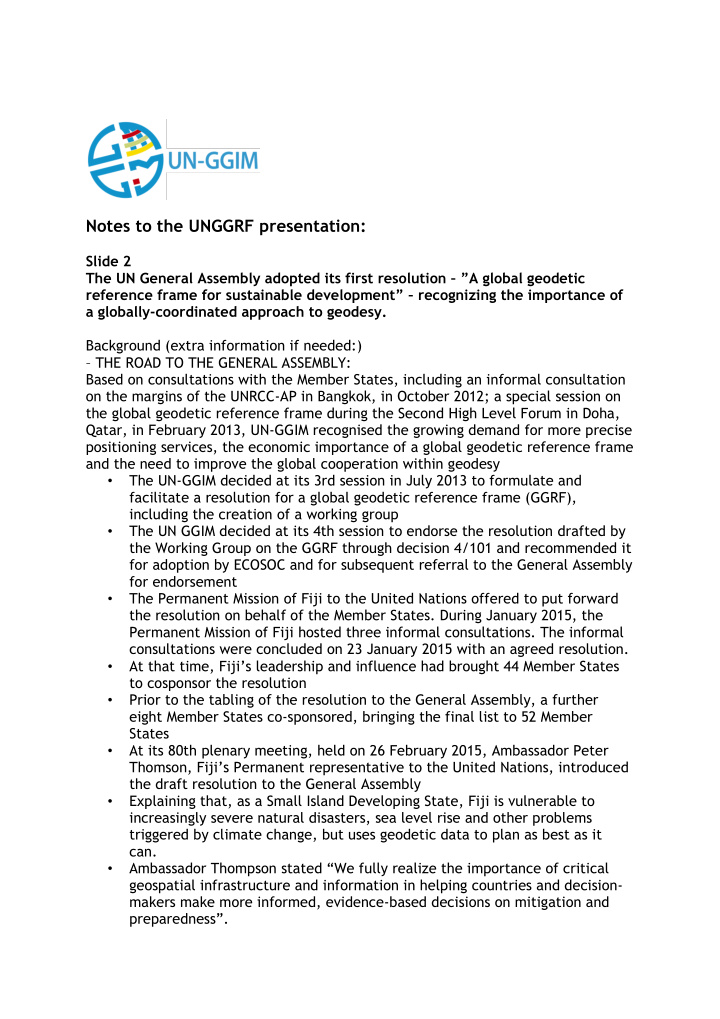



Notes to the UNGGRF presentation: Slide 2 The UN General Assembly adopted its first resolution – ”A global geodetic reference frame for sustainable development” – recognizing the importance of a globally-coordinated approach to geodesy. Background (extra information if needed:) – THE ROAD TO THE GENERAL ASSEMBLY: Based on consultations with the Member States, including an informal consultation on the margins of the UNRCC-AP in Bangkok, in October 2012; a special session on the global geodetic reference frame during the Second High Level Forum in Doha, Qatar, in February 2013, UN-GGIM recognised the growing demand for more precise positioning services, the economic importance of a global geodetic reference frame and the need to improve the global cooperation within geodesy • The UN-GGIM decided at its 3rd session in July 2013 to formulate and facilitate a resolution for a global geodetic reference frame (GGRF), including the creation of a working group The UN GGIM decided at its 4th session to endorse the resolution drafted by • the Working Group on the GGRF through decision 4/101 and recommended it for adoption by ECOSOC and for subsequent referral to the General Assembly for endorsement • The Permanent Mission of Fiji to the United Nations offered to put forward the resolution on behalf of the Member States. During January 2015, the Permanent Mission of Fiji hosted three informal consultations. The informal consultations were concluded on 23 January 2015 with an agreed resolution. • At that time, Fiji’s leadership and influence had brought 44 Member States to cosponsor the resolution • Prior to the tabling of the resolution to the General Assembly, a further eight Member States co-sponsored, bringing the final list to 52 Member States At its 80th plenary meeting, held on 26 February 2015, Ambassador Peter • Thomson, Fiji’s Permanent representative to the United Nations, introduced the draft resolution to the General Assembly Explaining that, as a Small Island Developing State, Fiji is vulnerable to • increasingly severe natural disasters, sea level rise and other problems triggered by climate change, but uses geodetic data to plan as best as it can. • Ambassador Thompson stated “We fully realize the importance of critical geospatial infrastructure and information in helping countries and decision- makers make more informed, evidence-based decisions on mitigation and preparedness”.
The General Assembly adopted the resolution on a Global Geodetic • Reference Frame for Sustainable Development (A/RES/69/266) 26 FEBRUARY 2015. Slide 4: ANIMATION FILM (approx. 3 minutes): (linked to website/vimeo) Through geodesy we measure changes in the shape, rotation and gravitational field of planet Earth. Have a look at this short animation film ON GEODESY AND THE GLOBAL GEODETIC REFERENCE FRAME – it will help you to understand the role geodesy and a global geodetic reference frame play in society and why geodesy is so important for the ongoing study of our changing planet. Slide 6: After the UN General Assembly adopted the resolution on 26 February a global questionnaire was sent to Member States for the purpose of gathering opinions on key elements of GGRF and its sustainability: The survey resulted in 92 responses from 84 countries Regional distribution: North America: 2 (50%) South America: 7 (54%) Caribbean: 8 (36%) Europe: 32 (67%) Middle East: 3 (14%) Asia: 11 (35%) Pacific: 4 (20%) Africa: 17 (27%) In some cases multiple organizations from the same country completed individual surveys. This is a good result for a survey and matches the response obtained on the Global Geodetic survey distributed in December 2012. (Percentages are calculated from the global total of countries in that region, not by number of countries the questionnaire was originally sent to). The respondents varied in organisational level from geodetic specialists up to directors, -- which may bias the focus of the respondents from technical to managerial issues respectively. Slide 7: Global survey summary results –presented at the UN-GGIM 5th session in August 2015: Key elements to achieving a sustainable GGRF Governmental and country commitment and funding Common standards International obligations Key elements for development of GGRF Maintain and build infrastructure Common standards Internationally coordinated policies
Slide 8: The GGRF working group is now drafting the roadmap to build a framework to implement the Global Geodetic Reference Frame. The structure of the roadmap document will include these broad sections . Each chapter references operational paragraphs from the UN General Assembly resolution The outcome, according to the UN General Assembly: the working group..: ”to develop a global geodetic road map that addresses key elements relating to the development and sustainability of the global geodetic reference frame” Slide 9: Communication and outreach is key in order to make the GGRF more visible and understandable to society. Communication objectives: To reach UN-GGIM delegates, decision makers, geodetic opinion leaders to communicate the importance of the GGRF Roadmap and why sustainable global cooperation on geodesy is key to meet the objectives of the UN GGRF Resolution. Twitter account @unggrf – with hashtag #ggrf Do also follow @unggim. Check out www.unggrf.org for more background and newsletters. Slide 10: First Drafting underway by December 2015. Slide 13: Since no single country can maintain the global geodetic reference frame alone: Global collaboration is a key element
Recommend
More recommend